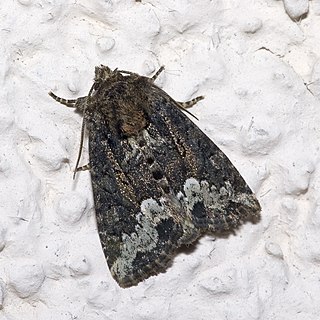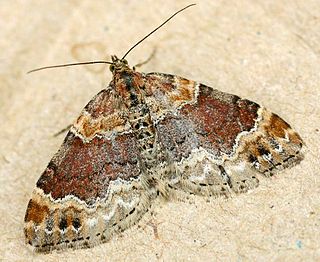
The mottled beauty is a moth of the family Geometridae. The species was first described by Carl Linnaeus in his 1758 10th edition of Systema Naturae.

The large yellow underwing is a moth, the type species for the family Noctuidae. It is an abundant species throughout the Palearctic realm, one of the most common and most familiar moths of the region. In some years the species is highly migratory with large numbers appearing suddenly in marginal parts of the range.

The lesser yellow underwing is a moth of the family Noctuidae.

Mythimna impura, the smoky wainscot, is a moth of the family Noctuidae. The species was first described by Jacob Hübner in 1808. It is distributed throughout most of the Palearctic realm from Ireland in the west of Europe east to the Caucasus, Turkey, Syria, Kazakhstan, Russia, Siberia, Mongolia, then Japan. In Europe it is found from the Arctic Circle to Spain and Italy in the south, as well as in the northern regions of Greece.

The dark dagger is a moth of the family Noctuidae. The species was first described by Michael Denis and Ignaz Schiffermüller in 1775. It is distributed throughout Europe, Turkey, the Near East, the European part of Russia, southern Siberia, the Ural, the Russian Far East, the Korean Peninsula, China and Japan (Hokkaido).

The grey dagger is a moth of the family Noctuidae.

The copper underwing, humped green fruitworm or pyramidal green fruitworm is a moth of the family Noctuidae. The species was first described by Carl Linnaeus in his 1758 10th edition of Systema Naturae.

Svensson's copper underwing is a moth of the family Noctuidae. The species was first described by Charles E. Rungs in 1949. It is distributed throughout Europe including Russia east to the Urals.

Apamea remissa, the dusky brocade, is a species of moth of the family Noctuidae. It is distributed throughout Europe and Turkey, ranging across the Palearctic realm to Siberia, Manchuria and Japan. It has also been reported from Alaska.

The spruce carpet is a moth in the family Geometridae. The species was first described by Alfred Jefferis Turner in 1925. It is a double-brooded species, meaning it has two broods in one year. Its wings are coloured with different shades of grey, but the spring brood tends to have more brown colours.

The marbled minor is a moth of the family Noctuidae. The species was first described by Carl Linnaeus in his 1758 10th edition of Systema Naturae. It is distributed throughout Europe, east through the Palearctic to central Asia and the Altai Mountains. It rises to heights of over 1500 meters in the Alps.

Catocala is a generally Holarctic genus of moths in the family Erebidae. The genus was erected by Franz von Paula Schrank in 1802. The moths are commonly known as underwing moths or simply underwings. These terms are sometimes used for a few related moths, but usually – especially when used in plural, not as part of a species name – they are used to refer to Catocala only.

Noctua is a genus of moths. They have dull, cryptic forewings and often very bright hindwings. These are hidden under the forewings when the moths rest, leading to their common name of yellow underwings. They are not particularly closely related to the "true" underwing moths (Catocala) though, apart from both being Noctuoidea. They are good fliers.

The mullein moth is a noctuid moth with a Palearctic distribution. The species was first described by Carl Linnaeus in his landmark 1758 10th edition of Systema Naturae.

Xanthorhoe spadicearia, the red twin-spot carpet, is a moth of the genus Xanthorhoe in the family Geometridae. The species was first described by Michael Denis and Ignaz Schiffermüller in 1775.

Orthosia incerta, the clouded drab, is a species of moth of the family Noctuidae, found in Europe and Asia. The occurrence of the species extends through all European countries through the Palearctic to the Russian Far East and Japan. It is absent from northern Fennoscandia and in the Alps it occurs up to 2000 m above sea level.

Noctua janthe, the lesser broad-bordered yellow underwing, is a moth of the family Noctuoidea. Some authors consider Noctua janthe and Noctua janthina to be the same species. It is found in Europe and North Africa.

Noctua interjecta, the least yellow underwing, is a species of moth of the family Noctuidae. It is found in Europe.

Noctua fimbriata, the broad-bordered yellow underwing, is a moth of the family Noctuidae. It is found in Europe, North Africa, Anatolia, the Caucasus, Turkey, Caucasus, Transcaucasia, Armenia, Turkmenistan and Novosibirsk Oblast. The border of its southern range is unclear because of the similar looking species Noctua tirrenica.

Noctua orbona, the lunar yellow underwing, is a moth of the family Noctuoidea. It is found in the Palearctic.





















